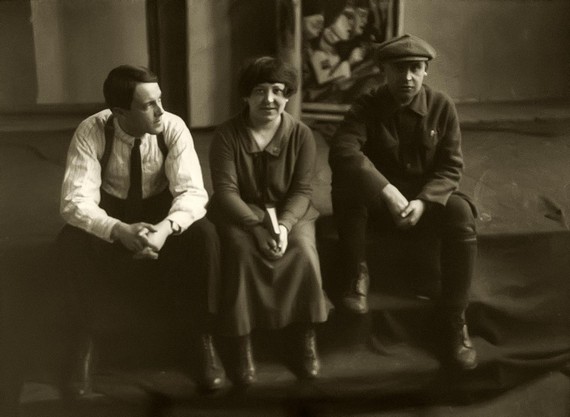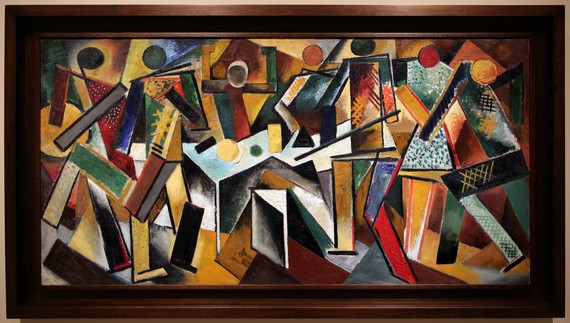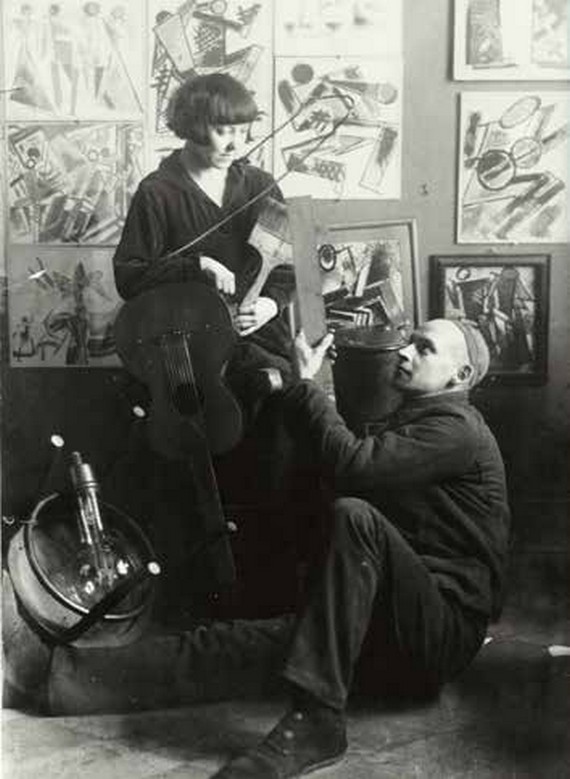Russian Designers – Varvara Stepanova
January 18, 2019Varvara Stepanova was a Russian artist and clothing designer who created an elegant new system of “classless” clothes for everyone after the Russian Revolution. Her designs were rooted in idealistic ideas of being anti-aesthetic, instead focussing on the core qualities of being functional, comfortable, easy to clean and long lasting, but were nevertheless extremely stylised and distinctive. They are much quoted and copied today.

Director Vitaly Zhemchuzhny Varvara Stepanova and Alexander Rodchenko during rehersal of the performance, 1924.
See page for author, Public domain, via Wikimedia Commons
Varvara Stepanova – the philosopher designer.
Varvara Fyodorovna Stepanova was born in Kovno, Russia, now Kaunas, Lithuania, on the 23rdOct 1894. She was born into a peasant family, but attended the Kazan art school, an achievement which was very unusual for someone of her upbringing.
Whilst she was there, she met her greatest collaborator Alexander Rodchenko. They began living together in 1916 and married in 1942.
But before that, Stepanova moved to Moscow in 1912, attending the Stroganov School and from 1914 gave private art lessons and had her first exhibition, at the Moscow Salon. After that, she worked as an accountant and a secretary in a factory.

Varvara stepanova painting, billiard players, 1920.
Francesco Bini, CC BY-SA 4.0, via Wikimedia Commons
The Constructivists
In 1916, Varvara Stepanova and Alexander Rodchenko rented an apartment from Wassily Kandinsky, and these three shared ideas about art, fashion, textiles, design and philosophy to become the core of the Russian avante-garde. Other members of the group included Kazimir Malevich , Vladimir Tatlin , Lyubov Popova , and Nadezhda Udaltsova . They were interested in Cubism, Futurism, and peasant art, and Stepanova created a series of artist books melding these influences around that time. She was still working in the factory as her day job.
This was before the Russian Revolution. Whilst some people like Lud, George Hueningen-Huene, and Iya Abdy found they and their families were under threat from the Revolution, perhaps because of their upper class backgrounds, Varvara Stepanova was on the other side, the side of the Revolutionaries. Whilst the aforementioned Russians ended up living and working in a very different fashion sphere, one which Stepanova would doubtless have labelled “Decadent Western Fashion”, she stayed and tried to help the state with its manifesto of making every person equal.
It was difficult for her and the other artists she knew, and they ended up having many late-night discussions about where, exactly, art could fit in and be useful, not merely decorative. Art, they agreed, was not meant to sit in galleries but be visible on the streets and in the workplace. This when Varvara Stepanova co-founded the Constructivists, a group who aimed to make functional items which were also beautiful. The Constructivist declaration of 1921 called for artists to give up painting and instead, design Soviet mass-media and mass-production as ‘artist-engineers’ or ‘productivists’.

Rodchenko-Stepanova.
See page for author, Public domain, via Wikimedia Commons
Art for Everyone
Her stage sets for Vsevolod Meyerhold ’s 1922 production of The Death of Tarelkin were acclaimed. They followed the lines of her clothing designs, which were themselves visually bold and costume like. Costume was called “Prozodezha” or “Production Clothing” for performers, and sportswear “Sportodezhda”. The design was very similar for both genders, with the only difference between male and female often being a (severely plain) skirt in place of trousers.
The clothes were designed to be functional, comfortable, and remove gender expectations and drew on both traditional peasant clothing and Cubism and Futurism, in bold, bright colours and patterns.
Varvara Stepanova – Professor of Textile Design
In 1924-25 she was the professor of textile design at the Vkhutemas University and was exhibited at the Exposition Internationale des Arts Décoratifs et Industriels Modernes in Paris.
A year later, fully attaining her aims of creating Industrial Art, and becoming the ultimate artist engineer or productivist, she also worked at the First State Textile Print Factory for a year, where she created 150 fabric designs at a feverish pace, 20 of which were produced. In 1929 she was awarded a prize for one of her designs at the Everyday Soviet Textiles exhibition at the Tretyakov Gallery.
However, though she was true to her own beliefs, from the late 1920s Stepanova’s work was critiqued by the Stalinists as being just too opaque and avant-garde. It did not stop her from being commissioned by the government for major book and journal designs in the next few years though.
Varvara Stepanova – Continued Innovation and Legacy
From the 1930s onwards, Stepanova continued her multi disciplinary painting and design in different areas, exhibiting often. She died in 1958 in Moscow.
In the end, though she was a pioneer in her artistic practices and especially as a woman in a world that was still entirely male dominated desite its idealism, many of Varvara’s designs for both textiles and clothing would never be produced due to wartime shortages and their complexities. Yet her vision lives on: in their simple bold shapes and graphic colour blocks Varvara Stepanova’s “Sportodezhda” were the forerunners of today’s tracksuits.